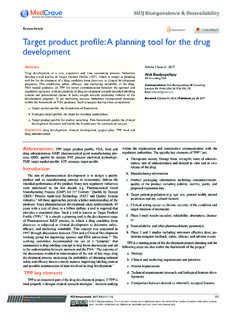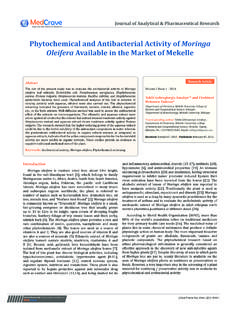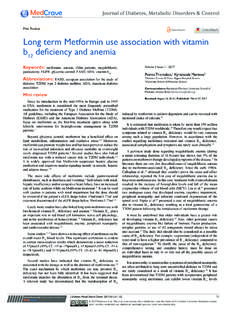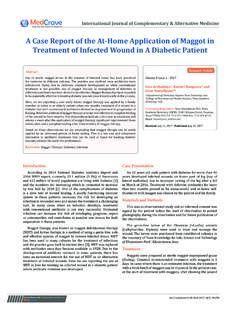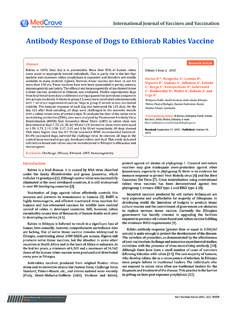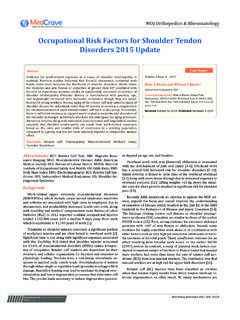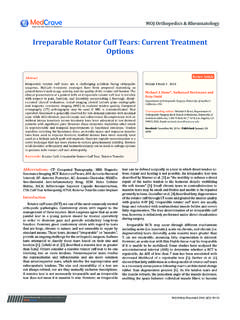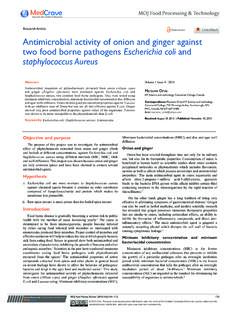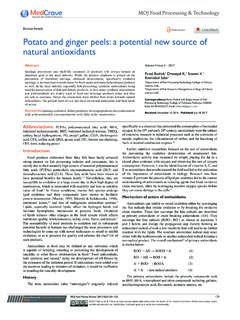Transcription of Behind Bars: The Truth about Drugs in Prisons - Medcrave
1 Forensic Research & Criminology International Journal Behind bars : The Truth about Drugs in Prisons Abstract Research Article The consumption and dealing of Drugs has long been a criminal offence, so how Volume 5 Issue 3 - 2017. are Drugs finding their way into Prisons that are meant to be secure places of law enforcement? To be able to confront the problem, an in-depth understanding is needed on the current situation of Drugs within Prisons . This review focuses on Department of Science and Technology Nottingham Trent three aspects, firstly looking at the main ways Drugs are trafficked into Prisons , University, UK. secondly looking at the issues linked to the use of Drugs within Prisons and finally evaluating what is being done to try to tackle the problem. Drugs find their way *Corresponding author: Andrew O'Hagan, Department into Prisons in numerous ways, which causes problems for the prison system.
2 Of Science and Technology, Nottingham Trent University, prison officials need to be able to keep up with the creative and inventive ways Nottingham, UK, Tel: +44115-8483153;. inmates are developing to traffic Drugs into Prisons . A third of prisoners in England Email: and Wales claimed it was easier to get hold of Drugs in prison than it was outside. This undermines prison security and creates problems with violence together Received: September 03 2017 | Published: September 14, 2017. being linked with reoffending. Two in five prisoners in England and Wales are known to commit offences in order to get funds to purchase Drugs . Health risks are created by inmates sharing syringes, leading to the transmission of infectious diseases. This in turn causes the costs of treatments and detection methods to spiral out of control.
3 Governments are constantly trying to proactively find ways to tackle Drugs in prison ; these include the use of sniffer dogs and employing more thorough searches by staff. But more needs to be done to eradicate Drugs completely. Keywords: Drugs ; Prisons ; Trafficking; Law-enforcement; Governments Abbreviations: AIDs: Acquired Immune Deficiency Syndrome; A 1998 study found that 75% of prisoners in England and Wales CSJ: The Centre for Social Justice; DIP: drug Interventions had, at taken illegal Drugs whilst in prison . Of inmates canvassed Programme; HBV: Hepatitis B Virus; HCV: Hepatitis C Virus; HIV: at HMP Birmingham and HMP Preston, 17% and 13% respectively Human Immunodeficiency Virus: IDU: Intravenous drug Users; reported that they had developed a drug addiction whilst in MDT: Mandatory drug Test; MoJ: Ministry of Justice; NPS: New prison [6,9].
4 Psychoactive Substances; OST: Opiate Substitution Treatment;. TB: Tuberculosis Introduction Research carried out for this review suggests that Drugs are rife in Prisons worldwide and illicit drug use such as cannabis, heroin and NPS remains endemic [1]. This review aims to discuss key aspects associated with the use of Drugs , predominantly within Prisons in England and Wales, to determine routes by which Drugs enter Prisons , key issues relating to the use of Drugs within Prisons as well as the efforts being made to create safer, drug free institutions. The exact extent of the Drugs problem in prison is not currently known, as individual institutions rarely exchange information relating to their internal drug markets [2]. Speculative figures, however, estimate that 75,000 drug users pass through the prison system in England and Wales every year [3].
5 Figure 1: The proportion of prisoners in England and Wales between Figures from the MoJ, as of 30th September 2016, state that April 2014 and August 2015 having problems with illicit substances. the prison population in England and Wales was 85,639, which It may therefore be that drug users continue a habit that they had already acquired before going to prison , as suggested by Figure 1. equates to of the conservative estimate of million Reconstructed from Roberts, 2015 [9]. people Dolan et al. [5], indicate as the global penal population [4,5]. drug use and dependence vary worldwide from 10% to Figure 2 shows the prevalence of the type of drug use among 48% among male inmates and 30% to 60% among female inmates inmates in European countries, the United Kingdom being in the [1,6-8]. Figure 1 shows the proportion of prisoners in England top four countries for each type of drug [10].
6 Research suggests and Wales (n=10,702), with problems with illicit substances [1]. that drug -using inmates dictate the daily routine in Prisons . This Submit Manuscript | Forensic Res Criminol Int J 2017, 5(3): 00158. Copyright: Behind bars : The Truth about Drugs in Prisons 2017 O'Hagan et al. 2/12. includes drug treatment programmes and control measures aimed of 3142 inmates across all operational Prisons in England and at preventing drug trafficking and violence [11]. Prisons become Wales in 1995. Although the number of prisoners who had used an effective vehicle for spreading drug use because it is easy for cannabis was greater than those using heroin, the percentage that drug users to establish social relationships and pass on their used both was around 60% [19]. drug habit, due to peer pressure and power of association.
7 The main reasons for using Drugs in Prisons are reportedly, to relieve insomnia, boredom (due to a lack of constructive activities) and as a coping mechanism [11-14]. drug using prisoners generally experience deprivation, poor education achievements together with unemployment issues, which inevitably lead to poor housing [13]. Of 86 subjects from two institutions in India, 83 (97%). reported that Drugs were available in their prison and 56 (65%). used Drugs whilst in prison [8]. With a third of all prisoners in England and Wales claiming that it was easy to get hold of illegal substances whilst in prison , to the extent that prisoners claimed it was easier to get hold of Drugs in prison than it was outside [15,16]. In Oakwood prison , in Staffordshire, it was said by inmates, that Drugs were easier to obtain than soap and in Brixton prison , London, Officers' uniforms smelt of skunk', a strong herbal form of cannabis that consists of buds, because it's use was so widespread [17,18].
8 Table 1 illustrates the prevalence of lifetime Figure 2: Lifetime prevalence (%) of illicit drug use among inmates in European countries [10]. drug use and drug use in prison . The information is from a sample Table 1: Prevalence of lifetime drug use and drug use in prison reconstructed from Boys et al. [19]. Frequency (% Ever used in prison Initiated use in prison Initiated use in prison (% of drug Type of Total) (% of all Users) (% of all Users) those used in prison ). Cannabis 2411 ( ) 1538 ( ) 154 ( ) 10. Amphetamines 1529 ( ) 216 ( ) 36 ( ) Cocaine/ Crack 1442 ( ) 351 ( ) 134 ( ) Heroin 1203 ( ) 743 ( ) 318 ( ) Injecting drug use 818 ( ) 130 ( ) 33 ( ) 25. Discussion of the more usual routes for Drugs to enter the prison system [3]. In England, there has been an increase in visitors being arrested How do Drugs get into Prisons ?
9 On suspicion of conveying Drugs . According to CSJ research, there drug routes into Prisons are numerous, varied and likely to were 300 cases in 2013/14, an increase of 10% in three years differ from prison to prison [9]. They often require sophisticated [6,15]. Approximately 5% of inmates reported that, during family planning and preparation, to circumvent systems put in place to visits, a family member would smuggle in substances for them [8]. prevent drug smuggling [20]. It has been stated, by a prison officer, A good example is the case of Charlotte Millward, a 35-year-old that prisoners could be inventive and creative in the ways of mother of two, who was seen reaching inside her undergarments bringing in Drugs , which makes the task of security management and handing 10 tablets to her boyfriend during a visit at Holme increasingly difficult [3].
10 Drugs are disguised in a variety of House prison in 2014. The tablets, worth around 2 each outside ways, which includes trying to disguise the smell, for example by of prison , were worth 40 inside the prison . For this offence, smothering the package with marmite [15]. Synthetic cannabis, Charlotte received a six-month suspended prison sentence [15]. In sprayed onto paper that is smoked, is often difficult to detect [9]. other examples, an ex-inmate told how he asked his sister to send The different ways Drugs enter Prisons are detailed below. heroin sewn into the hem of a towel, Drugs have been packaged in balloons so they can be swallowed and a lawyer was caught Visitors carrying Drugs in the sole of their shoes [16,17,22,23]. There have also been instances of visitors concealing Drugs wrapped in cling A common way that Drugs find their way into Prisons is film in body orifices, in baby's nappies or that have been passed through visitors.
